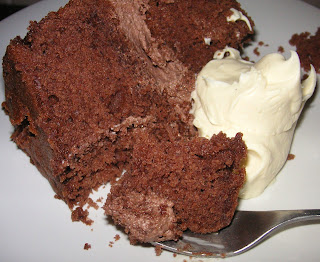
When I saw this lovely loaf cake on Sam’s blog I knew I had to make it. The recipe comes from the North Wales Tourism website so it must be authentic; I stress that because I thought Bara brith always contained yeast and this, clearly, doesn’t.
I can’t ever think about Wales now without “Gavin and Stacey” coming to mind. It is one of my favourite comedies of recent times and I was trying to think how the Welsh characters would describe this cake. Stacey would definitely call it “lush” whereas my favourite character, Nessa, would probably go for a more measured, “tidy”.
There’s something enticing and comforting about a fruity slice of cake spread with creamy, rich, yellow butter. As to how much butter – a friend of mine described this perfectly when she said “butter must be thick enough so you can leave teeth marks in it”. I couldn’t put it any better:
The most fun part of this recipe is soaking the fruit. Whether in tea (as for this recipe) or spirits (Christmas cake) I can never resist peeking in the pot to see how much of the liquid has been absorbed. The fruit turns glossy and plump – it’s practically botox for dried fruit!
I think there’s no point blogging if you’re not going to be honest and, the whole time I was baking this cake, I truly believed it would end up in the bin. So much so that as soon as it came out of the oven I started to bake a back-up cake! My first mistake was doubling the quantities to make two loaves – have you tried mixing that much fruit into a tiny amount of cake? Let’s just say that I now feel fully prepared to enter the next arm wrestling contest I come across. My second concern was that the mix was so dry; I added some milk until it at least started to look like a cake mix although milk was not included in the source recipe.
When the loaves came out of the oven they looked nobbly, hard and dry so I thought I should cut a slice to see what the inside was like. At this point they were still definitely heading for the bin. The cut slice started to comfort me – the crust which formed during baking was just a crust and the inside was moist and fruity. I tasted it and was underwhelmed. Still heading for the bin. But something made me butter it and try it how it is meant to be eaten. Please now imagine the Hallelujah chorus playing at full volume in my kitchen because it was delicious! It so needs the butter (salted) to bring all the flavour and texture alive. It’s heavenly!
Ingredients
450g mixed dried fruit – I used a mix of sultanas, raisins, currants, and blueberries
300ml tea – make as usual but don’t add the milk!
2 tablespoons marmalade
1 egg
6 tablespoons soft brown sugar
1 teaspoon mixed spice – I put a little extra as I like it spicy!
450g self raising flour
Milk as necessary
To glaze: honey
Salted butter to serve
Method
Start by soaking the fruit for 24 hours. Place all the fruit in a bowl and cover with the tea. Stir when you happen to walk past!
Preheat the oven to 170˚C/fan oven 150˚C/325˚F/Gas mark 3
Line a 900g loaf tin with baking paper – this will help you to get the loaf out of the tin.
Mix the marmalade, egg, sugar, spice and flour into the bowl containing the fruit and tea.
Spoon into the loaf tin and level the surface.
Bake for approximately 1 hour and 45 minutes or until a skewer, inserted into the centre of the loaf, comes out clean. After about an hour of baking check that the loaf isn’t browning too much – if it is, either move it down a shelf in the oven or loosely cover the top with foil.
Leave to stand in the tin on a wire rack for 10 minutes then turn out onto the wire rack.
Use a pastry brush to cover the top of the loaf with honey. As the loaf is so warm, the honey will melt and become easy to work with.
The cake will keep for several days in an airtight tin.
Serve in slices, thickly buttered.
Bask in the glory of the wonderful thing you have created.
Eat.



































